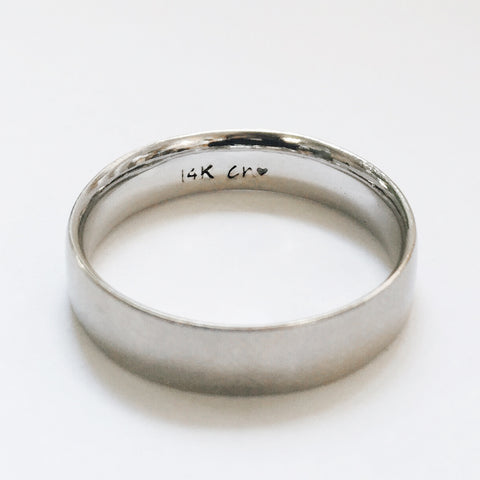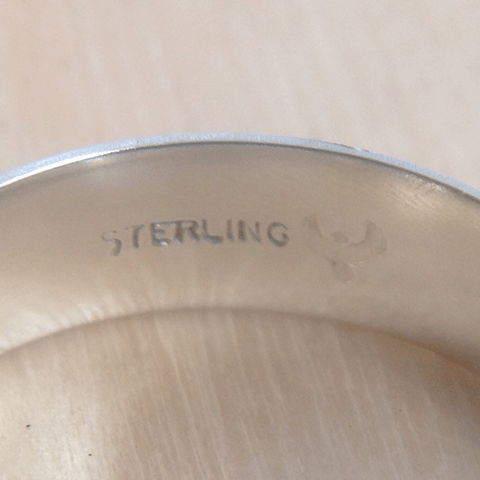
When you present an item to a jeweler for inspection or repair, the first thing they will do is flip it over to search for a hallmark. Why? Because a wealth of knowledge can be learned from these small marks imprinted on your jewelry!
A hallmark is an official stamp found on precious metal items that indicate the composition of the metal and its purity. Hallmarks may also include valuable information about the jewelry’s manufacturer and origin.
There are two types of marks commonly found on jewelry:
- a hallmark indicates the type of precious metal and its purity
- a makers mark is a symbol or initials that indicate the maker or origin of the jewelry
In order for a stamp to be a true hallmark, it must contain the purity stamp. A makers mark alone is not considered a hallmark.
HALLMARKS
Hallmarks, often called quality marks or purity marks, are a shorthand for the type of precious metal that makes up the piece. This stamp can be applied by the by the maker or an assay’s office and guarantees the minimum precious metal content present in the jewelry.
Below are a few common purity marks found on precious metal jewelry in the United States:
STAMP |
PRECIOUS METAL |
COMPOSITION |
|---|---|---|
| 10K | 10 karat gold | 41.6% gold, 58.4% alloy |
| 14K | 14 karat gold | 58.5% gold, 41.5% alloy |
| 585 | 14 karat gold | 58.5% gold, 41.5% alloy |
| 18K | 18 karat gold | 75% gold, 25% alloy |
| 750 | 18 karat gold | 75% gold, 25% alloy |
| 22K | 22 karat Gold | 91.6% Gold, 8.4% alloy |
| 24K | 24 karat gold | 100% Gold |
| 950PD | palladium | 95% palladium, 5% alloy |
| 950PT | platinum | 95% platinum, 5% alloy |
| PLAT | platinum | 95% platinum, 5% alloy |
| STER | sterling silver | 92.5% silver, 7.5% alloy |
| 925 | sterling silver | 92.5% silver, 7.5% alloy |
MAKERS MARKS
The look of each maker's mark will be unique to the artist who made it. Often the mark will be the company’s logo or the initials of the artist.

The makers mark for Corey Egan jewelry is composed of my initials, “CE”
Examples of Makers Marks
Tracing a symbol back to its maker can be tricky. Some countries, including the United States, do not require the manufacturer to register their maker’s marks. But for antique jewelry and jewelry created abroad, many marks are registered and can be found through search.
Here are some great places to start researching your makers marks:
-
Langs Antiques - makers marks database
-
Hallmarks Research Institute - a great resource for information on hallmarks along with a list of links for sites to research your own
-
Assay's Office - anatomy of a hallmark
Why Do We Hallmark Jewelry?
By stamping a piece of jewelry with its purity and makers mark, the maker assumes responsibility for the accuracy of its contents. The hallmark offers a level of assurance and protection for the consumer, as well as a helpful guide for any jeweler down the line who may need to sell or repair the jewelry.
Hallmarks Around the World
The requirements for hallmarking jewelry vary from country to country.
European countries often have a more rigorous standard for marking their precious metal goods. In many places, an item is not legal for sale without the presence of a hallmark. In the United Kingdom, an additional stamp on each piece is required from the assay’s office making it legal for sale. This third party tests each piece of jewelry before applying its own stamp as a guarantee.
In the United States, makers are not required to stamp their jewelry. But it sure is a good practice to do so!
While not every piece of jewelry will have a hallmark, their presence is helpful for appraisers, jewelers, and for the consumer's peace of mind. Next time you put on your favorite necklace or ring, take a moment to read its hallmarks. You’ll be surprised at what you can learn!










